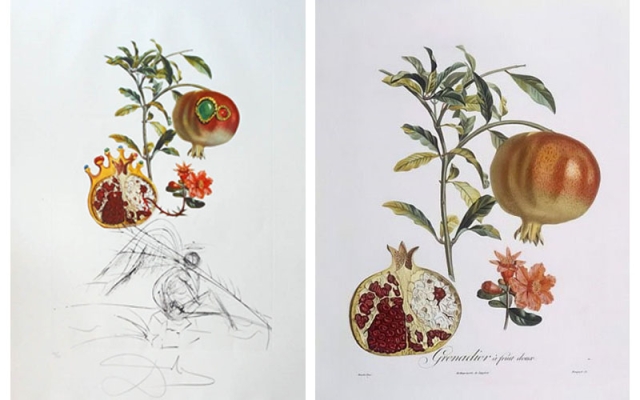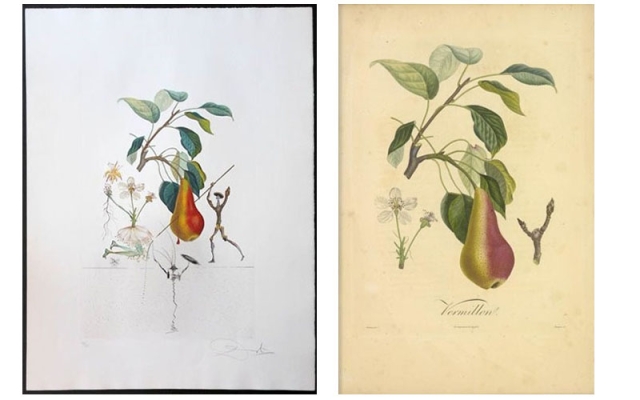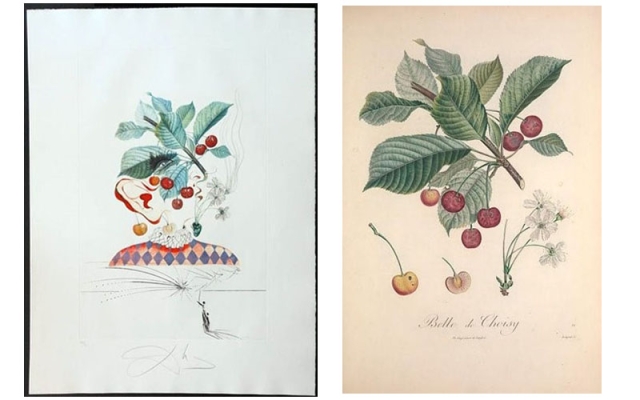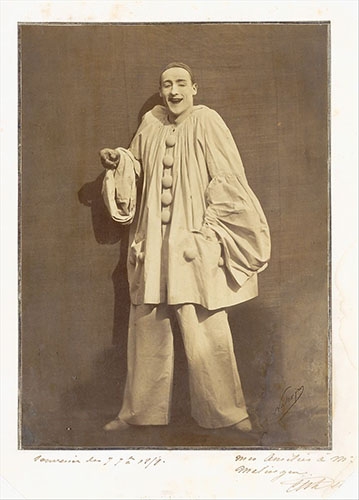Salvador Dalí’s Strange Fruit Garden
On view at the Gardens through August 22, Salvador Dalí: Gardens of the Mind features prints of strange and fanciful plants by renowned Spanish surrealist Salvador Dalí. Mixing flora with the artist’s signature motifs, two series of prints, FlorDalí and Surrealist Flowers, underscore Dalí’s ongoing infatuation with his native landscape of Catalonia. The images of fruits and flowers juxtapose seemingly incongruent elements to create surprising, hybrid plants—part flora, part animal and human, and part object.
The prints in Gardens of the Mind are a unique combination of painting, lithography and engraving over 19th century botanical illustrations. The underlying illustrations were created by well-known artists such as Pierre-Joseph Redouté (1759-1840), Pierre Antoine Poiteau (1766-1854), and Pierre Jean François Turpin (1775-1840). While the exhibition mainly consists of florals, 12 works from the FlorDalí series depict fruits. Most of the original illustrations for these fruits come from a 1946 volume of botanical illustrations titled "Pomologie française: recueil des plus beaux fruits cultivés en France (French Pomology: Collection of the Most Beautiful Cultivated Fruits in France)" by Poiteau and Turpin. This volume was an extension of Duhamel du Monceau’s (1700-1782) "Traite’ des Arbrés frutiers (Treatise on fruit trees)" published 1801.
Below, explore Dalí’s fanciful fruit illustrations alongside their 19th century counterparts.
Grenade et L'ange (Pomegranate and the Angel)

Left: Salvador Dalí, Grenade et l'ange (Pomegranate and the Angel), from the FlorDalí series, engraving of 19th century botanical illustration with gouache alterations, 1969, collection of The DalÍ Museum, St. Petersburg, FL. © 2021 Salvador Dalí, Fundació Gala-Salvador Dalí, Artists Rights Society. Right: Jean François Turpin, Grenadier a ruit doux, from Pomologie francaise: recueil des plus beaux fruits cultives en France, vol. 2, hand-colored engraving, 1846.
Based on an illustration originally created by French artist and botanist Pierre Jean François Turpin, this piece plays off the jewel-like quality of pomegranate seeds, while the tendril connecting the flower to the fruit is suggestive of something more creature than plant. Below the altered illustration is an engraved sketch of an angel.
Poire Don Quixote (Don Quixote Pear)

Left: Salvador Dalí, Poire Don Quixote (Don Quixote Pear), from the FlorDalí series, engraving of 19th century botanical illustration with gouache alterations, 1969, collection of The Dalí Museum, St. Petersburg, FL. © 2021 Salvador Dalí, Fundació Gala-Salvador Dalí, Artists Rights Society. Right: Pierre Jean François Turpin and Pierre Antoine Poiteau, Poire Vermillion from Pomologie Francaise: recueil des plus beaux fruits cultives en France, vol. 3, hand-colored engraving, 1846.
In Poire Don Quixote (Don Quixote Pear), Jean François Turpin’s pear illustration is transformed into figures; the twig into Don Quixote and the flower into the damsel in distress (Dulcinea del Toboso). Below the altered illustration is an engraving of a figure holding a weapon and a shield, either representing Sancho Panza or Quixote’s enemy.
Don Quixote, the well-known work written by Miguel de Cervantes, takes place in 16th century Spain and details the exploits of the self-proclaimed knight Don Quixote of La Mancha and his faithful squire Sancho Panza.
Cerises Pierrot (Pierrot Cherries)
In Cerises Pierrot (Pierrot Cherries), the negative spaces of the cherries, leaves, and stems are transformed to create a portrait of the popular French character Pierrot.

Left: Salvador Dalí, Cerises Pierrot (Pierrot Cherries), from the FlorDalí series, engraving of 19th century botanical illustration with gouache alterations, 1969, collection of The Dalí Museum, St. Petersburg, FL. © 2021 Salvador Dalí, Fundació Gala-Salvador Dalí, Artists Rights Society. Right: Pierre Jean François Turpin and Pierre Antoine Poiteau, Poire Vermillion from Pomologie Francaise: recueil des plus beaux fruits cultives en France, vol. 2, 1846.
The commedia dell’arte character known variously as Piero and Pedrolino was introduced to France in the 16th century by a group of Italian traveling actors who reached the court of Henri III. Commedia dell’arte was a form of Italian theater and ensemble acting in which a recurring group of characters acted out different scenarios; most commonly a young couple being thwarted by their parents. Columbina, a maidservant, was often paired in love matches with Pedrolino, who was known during this time for his unrequited love for her and his comedic foolish manner.

Nadar, Pierrot Laughing, gelatin-coated salted paper print, 1855. Collection of the Metropolitan Museum of Art, New York City, NY.
In 1660, the French version of Pierrot emerged when French playwright Molière adopted the character for his 1660 comedy “The Feast with the Statue.” In the 1900s, French mimes Jean-Gaspard Deburau (1796-1846) and Paul Legrand (1816-1880) enshrined Pierrot within French culture, establishing him as a sensitive and anguished artist. This conception of the character was celebrated and explored in several French films and plays in the 20th century. Despite his changes in personality, Pierrot is recognizable with his ruffled collar, white loose clothing, red lips, white painted face, and a pipe.
Don’t miss these whimsical works imbued with creativity, humor and allegory, on view through August 22.
Add new comment